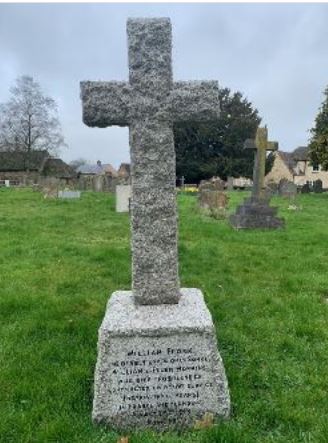Royal Engineers

Several of the military records relating to Sapper Hopkins feature only one first name, Frank, which may well be the name by which he was known.
It is believed that William Frank Hopkins was born at Reading, Berkshire in 1896 and he was the son of William Hopkins (1851-1932), a consultant engineer and his wife Ellen (1851-1940): her maiden name has not been identified. The couple appears to have had two children, Ellinor Joyce (born 1891) and William Frank.
The family appears to have moved around a lot. Frank having been born in Reading, by the time of the 1901 Census they were living at 25 Shakespeare Road, Hanwell, west London (now part of the London Borough of Ealing). When the 1911 Census was taken they had moved to Stradcona, Moor End Park Road, Cheltenham. Frank was then aged 14 and still at school. His father appears as an ‘engine water contractor’. At some point, after this census the family home appears to have moved to The Cedars, Leonard Stanley.
In the absence of any Army Service or detailed Pension Records specific details of Frank’s army service a sparse. It is known from the Silver War Badge records that he first enlisted (which would have been as a volunteer) on 2 September 1914, when he would have been 18. According to the Medals Roll for the Royal Engineers, Frank was initially assigned to the 6th Battalion of the Somerset Light Infantry, which had been formed at Taunton in August 1914 and soon after underwent training at Aldershot, becoming part of 43rd Brigade, 14th Division. On 21 May 1915 it landed at Boulogne, to join the British Expeditionary Force. Frank has a Medal Rolls Index Card, which states that he first went abroad on 21 May 1915, presumably with the 6th Somerset Light Infantry.
At a future date and for reasons unknown Frank transferred to the Royal Engineers (RE). This was possibly after being returned to the UK after being wounded or due to sickness; in the absence of detailed service records, it is impossible to say. It is not known if he saw service abroad with the RE. He ended up at the RE’s Signals Depot at Bedford.
Frank was discharged from the Army due to sickness on 2 May 1918. A recently released Pension Record Card states that he was suffering from pulmonary tuberculosis, attributed to his war service. He died, at home, on 26 August 1918, aged 22 and was buried in the churchyard of St Swithuns, Leonard Stanley four days later. A granite stone cross, mounted on a plinth, marks his grave. He is commemorated on the Leonard Stanley War Memorial.
The Gloucestershire Echo of 28 August 1918 carried a Notice of Death, which read ‘only son of W & E Hopkins; from illness contracted after two years and ten months’ active service in France’. This may indicate that he served abroad until March 1918.
Researched by Graham Adams 30 May 2021
